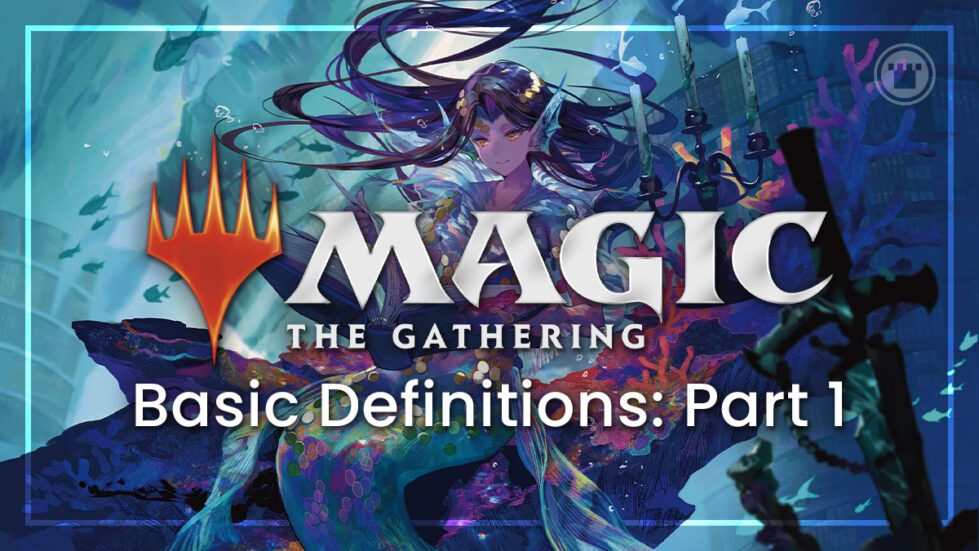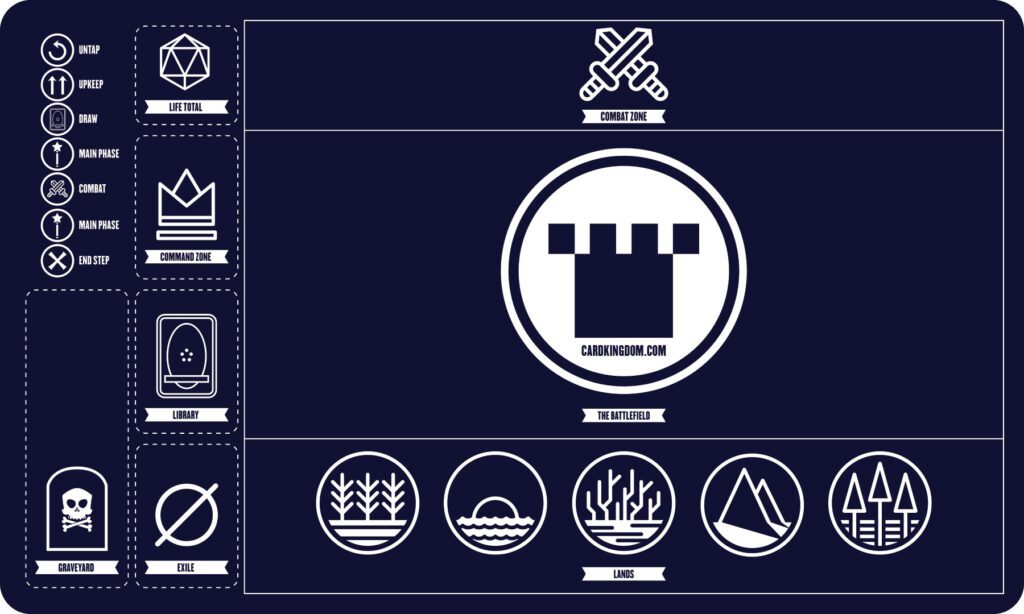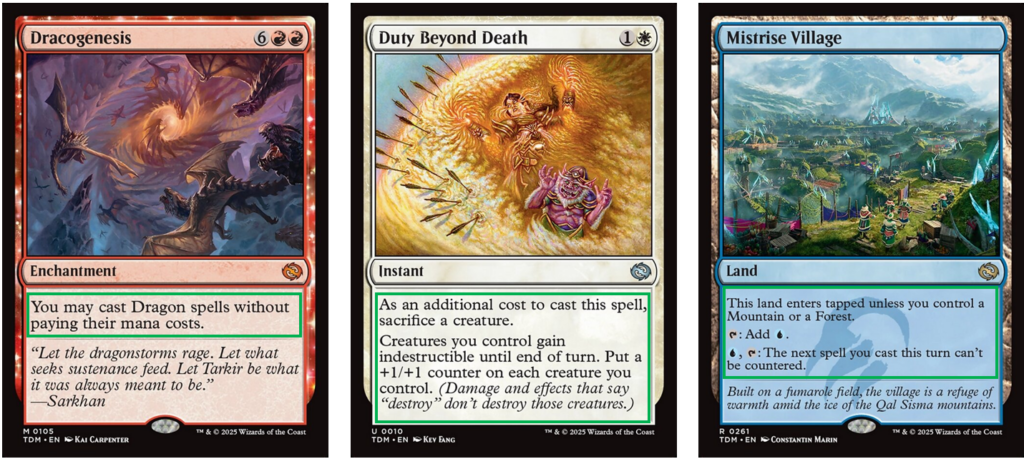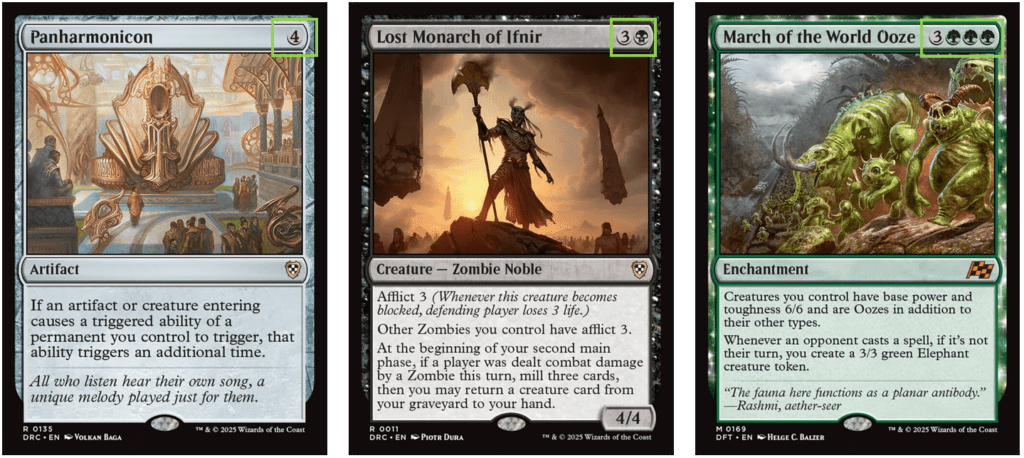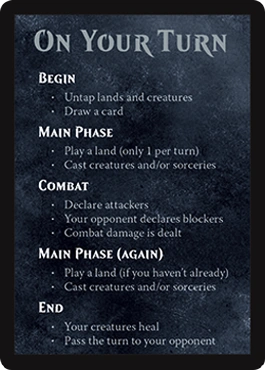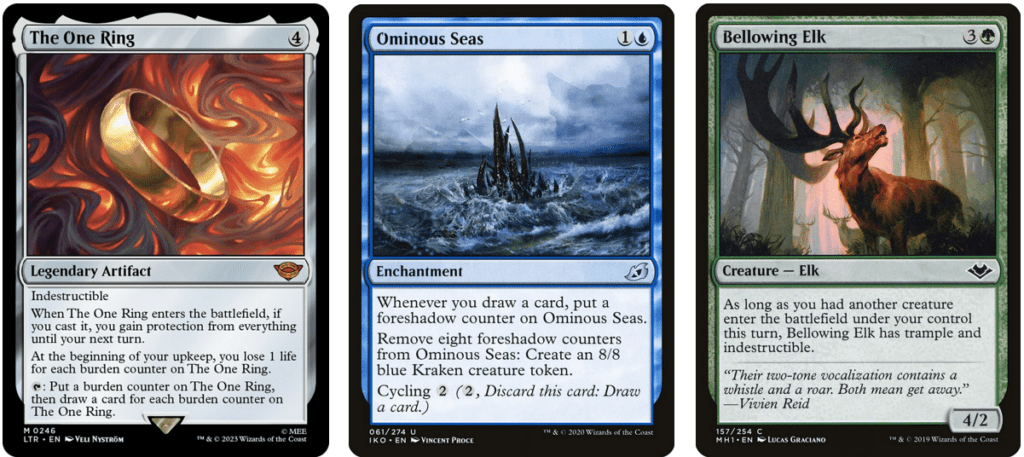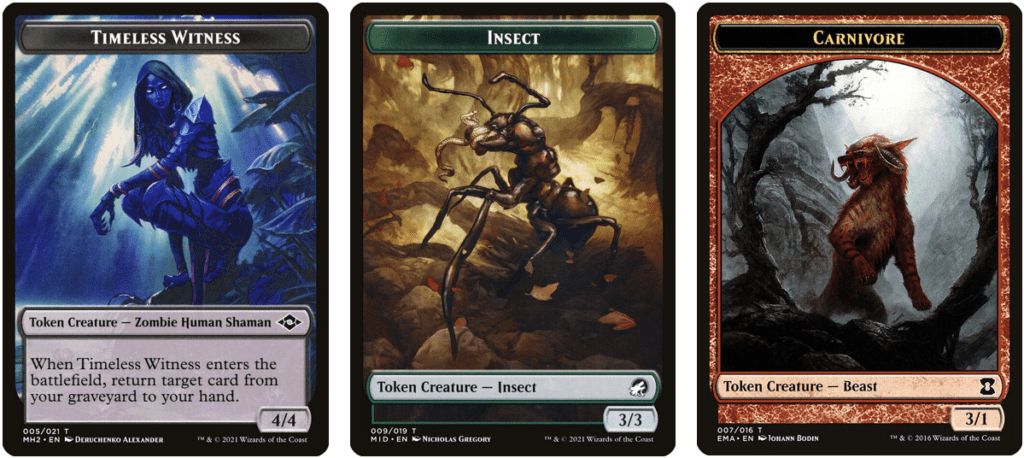Players who pick up Magic: The Gathering for the first time face an intimidating learning curve, that’s for sure. But the first and most important step is mastering the game’s unique language: an arcane vocabulary of keywords, rules terms and specific phrasing that holds the key to understanding every card from the last thirty years of Magic.
It would take an awful lot of article space for me to fully explore that vocabulary here. But we can start by looking at just those terms which are absolutely essential – ones which play a role in every game of Magic, even your first ones.
Battlefield / Library / Graveyard
These terms can be found everywhere across the Magic rules and in: they refer to the different “zones” that a card can be found in during a game. A player’s hand of cards is another of these zones (although the rules refer to that one without a cool fantasy name). A card can only be in one zone at a time, and which zone it’s in currently changes how the rules refer to it and how you can use it.
In more plain terms: a player’s “library” is their face-down deck of cards, from which they draw. Their “graveyard” is their discard pile, where most cards are sent after their effects are used up or they are destroyed by an opponent. The “battlefield” is a single, shared “in-play” area where most of the action in a game happens.
There are a couple of other zones (including “exile” and the “command zone”) but cards don’t naturally move in or out of these unless specific rules and effects tell them to.
Land
Every Magic card belongs to one or more “card types” which determine the basic rules of how they work. Land is perhaps the most important type, because land cards are what you use to pay for the costs of every other card!
Lands themselves are the only cards that do not cost resources to play. Instead, players are limited to playing one land each turn from their hand (colloquially called their “land drop”). Making sure you have enough land cards in your deck and hand to always play one each turn is one of the most important priorities for good players.
Ability
Magic cards almost always have a lot of rules text on them. Unless the card in question is an instant or a sorcery type, that text will be divided up into individual “abilities”, describing the effects it has while in play or (more rarely) when in another zone like the hand or graveyard.
Abilities are divided into a few categories, based on when and how they can be used. Static abilities are “always on” while the card is in play. Activated abilities have discrete effects that can be set off when and how you choose, but usually require you to pay a cost first. Triggered abilities only come into effect when some other condition in the game becomes true.
The rules will not spell out which category an ability belongs to, but experienced players can usually recognize the different language or formatting associated with each of them.
Mana
Mana is the main currency of Magic, used to pay the costs associated with most abilities and non-land cards. Most decks produce the mana they need by playing and then tapping land cards, although there are many more esoteric ways to generate it.
You don’t always need to say what you’re spending your mana on as you produce it, but you do need to spend it on something quickly. Any unspent or “floating” mana vanishes when the current turn ends, or even when moving between steps and phases of the current turn (see below).
Mana Cost / Mana Value
Some rules and effects care about a card’s “mana value” as a measure of how expensive the card is. A card’s mana value is the total amount of mana required to play it, expressed as a single integer. Mana value ignores any additional or optional costs besides the default casting cost (usually printed on the top-right of the card).
Mana value (sometimes referred to on older cards as “converted mana cost”) is never concerned with which specific colors of mana are included in the card’s actual printed cost – each colored pip just counts as 1 value. Any other exotic mana symbols and scenarios (such as cards with more than one printed cost) have their mana value calculated according to specific rules. For example, an “X” mana symbol does not usually add anything to a cards mana value, except in specific situations.
Tap
To “tap” a card during a game means to turn it sideways on the battlefield, leaving it horizontal. Most cards can only attack or use their abilities once per turn, and tapping the card is how you show that this once-per-turn power has been used up. Abilities which require the card to tap will show the “tap symbol”, a rightwards-facing arrow, as part of their cost.
Once a card has been tapped, you cannot use that card in a way which would require you to tap it again. Blocking an opposing attack does NOT require you to tap the blocking creature, but creatures which are tapped already cannot be used to block. Your cards will stay tapped until the start of your next turn, when the “untap step” happens and you turn them all back to their normal position to show they’re ready to use.
Turn / Phase / Step
Although it can be played fast and loose in casual settings, games of Magic actually follow a very detailed and consistent order of operations. Each player’s turn is broken down into a fixed sequence of phases: Beginning, Main Phase 1, Combat, Main Phase 2, Ending.
Each phase is further broken down into specific steps which mark out the important moments in a turn. For example, the “Beginning Phase” contains the “Untap Step” where you untap all the cards you tapped last turn, the “Upkeep Step” where various ongoing card abilities take effect, and the “Draw Step” where you draw a card.
It’s not essential to memorise the whole turn structure to play your first games, especially if you have more experienced opponents or mentors around to keep track of things. But it’s good to start tuning your ear for the names of different steps and phases so you can build that understanding as you get more comfortable with Magic.
Permanent
Permanent is what the Magic rules call any card which is currently on the battlefield (i.e. alive and in play). A creature card in your hand is not a permanent, nor is a creature card in your graveyard which you played earlier on in the game. But any creatures, lands, artifacts, enchantments, planeswalkers or battles you have in play are all permanents, even if some of them are tokens (see below).
You may also see the term “permanent card” used in some card abilities. A “permanent card” is any card which can become a permanent, but isn’t on the battlefield right now – so any card that isn’t of the instant or sorcery card types.
Summoning Sickness
This idiosyncratic term describes a specific rule applied to creatures (and only creatures) that helps to even the balance between attacker and defender. A creature has summoning sickness from when you first gain control of it, until the next time you start a new turn.
Creatures with summoning sickness cannot attack, and they cannot use abilities with the “tap symbol” in the cost either – but they CAN be used to block an opponent’s attack, since that does not tap your creature the way attacking does. Also, some creatures have the “haste” keyword, which means they ignore this rule completely and can attack or use tap abilities as soon as they come into play!
Token
Most of the time when you’re dealing with permanents, the math is very simple. You play a creature card that becomes one creature permanent, so you leave the card in play to represent that creature’s status. But that’s not always the case. Some cards represent a collection of similar creatures, or a creature who summons lesser underlings as part of their abilities.
Whenever these rules call for the creation of a permanent not directly represented by a specific card, you’ll be using a token to represent it. Tokens follow almost the exact same rules as other permanents (unless some rules specifically care about their token status), except that they cannot exist outside the battlefield. If a token has to move to the graveyard, hand or any other zone, even temporarily, it vanishes forever – and unless it was on its way to the graveyard, it won’t even count as having died.
Control / Own
When the Magic rules refer to the “controller” of a card or other object, it means what you would expect: the player who currently has that object on their side of the battlefield, who is responsible for deciding how and when to use it. This is also the player referred to when the rules for a card say “you” or “your”.
However, Magic is a game where you can sometimes steal or be given control of objects which originally belonged to someone else! In this case you become the new “controller” of the card, but it is still “owned” by the player who started with it in their deck (or the player who created it, in the case of a token).
Cards only count as “under your control” while they are alive on the battlefield. If a card on the battlefield has to move to the graveyard, hand, library or any other zone, it always goes to the graveyard, hand, etc. of its original owner.
GREATNESS (PARTIALLY) DEFINED…
That’s all we have time for this week, but we’ve only just scratched the surface of Magic’s intricate jargon. New players, keep your eyes peeled for this series of definitions to continue very soon – and for now, may you make good use of this knowledge to kickstart your spellcasting careers!
Are you new to Magic and want more content teaching you about the game? Sign-up for our emails and we’ll make sure you’re in the know about new content!

Tom’s fate was sealed in 7th grade when his friend lent him a pile of commons to play Magic. He quickly picked up Boros and Orzhov decks in Ravnica block and has remained a staunch white magician ever since. A fan of all Constructed formats, he enjoys studying the history of the tournament meta. He specializes in midrange decks, especially Death & Taxes and Martyr Proc. One day, he swears he will win an MCQ with Evershrike. Ask him how at @AWanderingBard, or watch him stream Magic at twitch.tv/TheWanderingBard.

